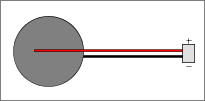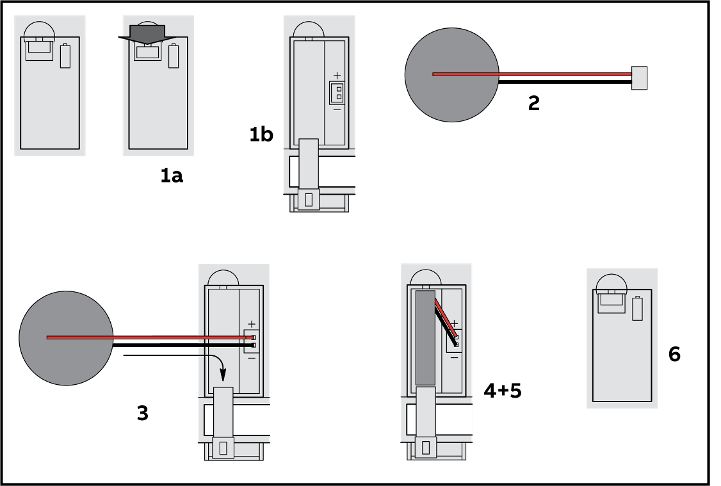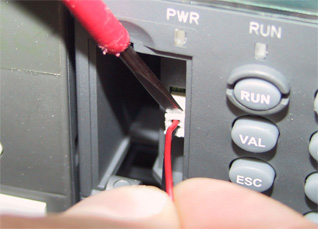-
Adapter cable with encapsulated primary button cell
-
Contains a manganese dioxide lithium primary button cell, 3 V, 560 mAh
-
Non-rechargeable
Purpose
The TA521 accessory is used to provide a zero-voltage-safe power supply for the remanent memory and the real-time clock of the AC500 V3 CPU modules PM5630, PM5650, PM5670, PM5675.
TA521 is the only accessory that may be used for this purpose.
The accessory TA521 is not included with the AC500 V3 CPUs. This accessory must be ordered separately.
Handling instructions
-
Do not short-circuit or re-charge the primary lithium battery! It can cause excessive heating and explosion.
-
Do not disassemble the primary lithium battery!
-
Do not heat up the primary lithium battery and not put into fire! Risk of explosion.
-
Store the primary lithium battery in a dry place.
-
Replace the primary lithium battery with supply voltage ON in order not to risk data being lost.
-
Recycle exhausted primary lithium batteries meeting the environmental standards.
Primary lithium battery lifetime
The primary lithium battery lifetime is the time the primary lithium battery can store data while the processor module is not powered. As long as the processor module is powered, the primary lithium battery will only be discharged by its own leakage current.
To avoid a short primary lithium battery discharge, the primary lithium battery should always be inserted or replaced while the processor module is under power, then the primary lithium battery is correctly recognized and will not shortly discharged.
Insertion
To ensure proper operation and to prevent data loss, the primary lithium battery insertion or replacement must be always done with the system under power. Data buffering is not possible without the primary lithium battery and power supply at the same time.




WARNING

Risk of fire or explosion!
Use of incorrect primary lithium battery may cause fire or explosion.
-
Open the compartment with the small locking mechanism, press it down and slip down the door. The door is attached to the front panel of the processor module and cannot be removed.
-
Remove the TA521 from its package and hold it by the small cable. Remove then the small connector from the socket, do this best by lifting it out with a screwdriver.
-
Insert the connector of the adapter into the small connector port of the compartment. The connector is keyed to find the correct polarity (red = positive pole = above).
-
Insert first the cable and then the adapter into the compartment, push it until it reaches the bottom of the compartment.
-
Arrange the cable in order not to inhibit the door to close.
-
Pull-up the door and press until the locking mechanism snaps.
In order to prevent data losses or problems, the primary lithium battery should be replaced after 3 years of utilisation or at least as soon as possible after receiving the "low primary lithium battery warning" indication.
Do not use a primary lithium battery older than 3 years for replacement, do not keep primary lithium battery too long in stock.
Replacement of the adapter cable with button cell
To ensure proper operation and to prevent data loss, the primary lithium battery insertion or replacement must be always done with the system under power. Data buffering is not possible without the primary lithium battery and power supply at the same time.
-
Open the compartment with the small locking mechanism, press it down and slip down the door. The door is attached to the front panel of the processor module and cannot be removed.
-
Remove the old TA521 adapter cable with button cell from the compartment by pulling it by the small cable. Remove then the small connector from the socket, do this best by lifting it out with a screwdriver.
-
Follow the previous instructions to insert a new adapter.




CAUTION

Risk of explosion!
Do not open, re-charge or disassemble primary lithium battery. Attempting to charge primary lithium battery will lead to overheating and can cause explosions.
Protect them from heat and fire and store them in a dry place.
Never short-circuit or operate primary lithium battery with the polarities reversed. The primary lithium battery are likely to overheat and explode. Avoid unintentional short circuiting do not store primary lithium batteries in metal containers and do not place them on metallic surfaces. Escaping lithium is a health hazard.
In order to prevent data losses or problems, the primary lithium battery should be replaced after 3 years of utilisation or at least as soon as possible after receiving the "low primary lithium battery warning" indication.
Do not use a primary lithium battery older than 3 years for replacement, do not keep primary lithium battery too long in stock.
|
Parameter |
Value |
||
|---|---|---|---|
|
Nominal voltage |
3 V |
||
|
Nominal capacity |
560 mAh |
||
|
Temperature range (index below C0) |
Operating: 0 °C ... +60 °C Storage: -20 °C ... +60 °C Transport: -20 °C ... +60 °C |
||
|
Temperature range (index C0 and above) |
Operating: -40 °C ... +70 °C Storage: -40 °C ... +85 °C Transport: -40 °C ... +85 °C |
||
|
Primary lithium battery lifetime |
Typ. 3 years at +25 °C |
||
|
Self-discharge |
2 % per year at +25 °C 5 % per year at +40 °C 20 % per year at +60 °C |
||
|
Protection against reverse polarity |
Yes, by mechanical coding of the plug. |
||
|
Insulation |
The adapter cable with button cell is completely insulated. |
||
|
Connection |
Red = positive pole = above at plug, black = negative pole, |
||
|
Weight |
7 g |
||
|
Dimensions |
Diameter of the adapter cable with button cell: 24.5 mm Thickness of the adapter cable with button cell: 5 mm |
Ordering data
|
Part no. |
Description |
Product life cycle phase *) |
|---|---|---|
|
1SAP 180 300 R0001 |
TA521, adapter cable with primary button cell |
Active |
*) Modules in lifecycle Classic are available from stock but not recommended for planning and commissioning of new installations.




